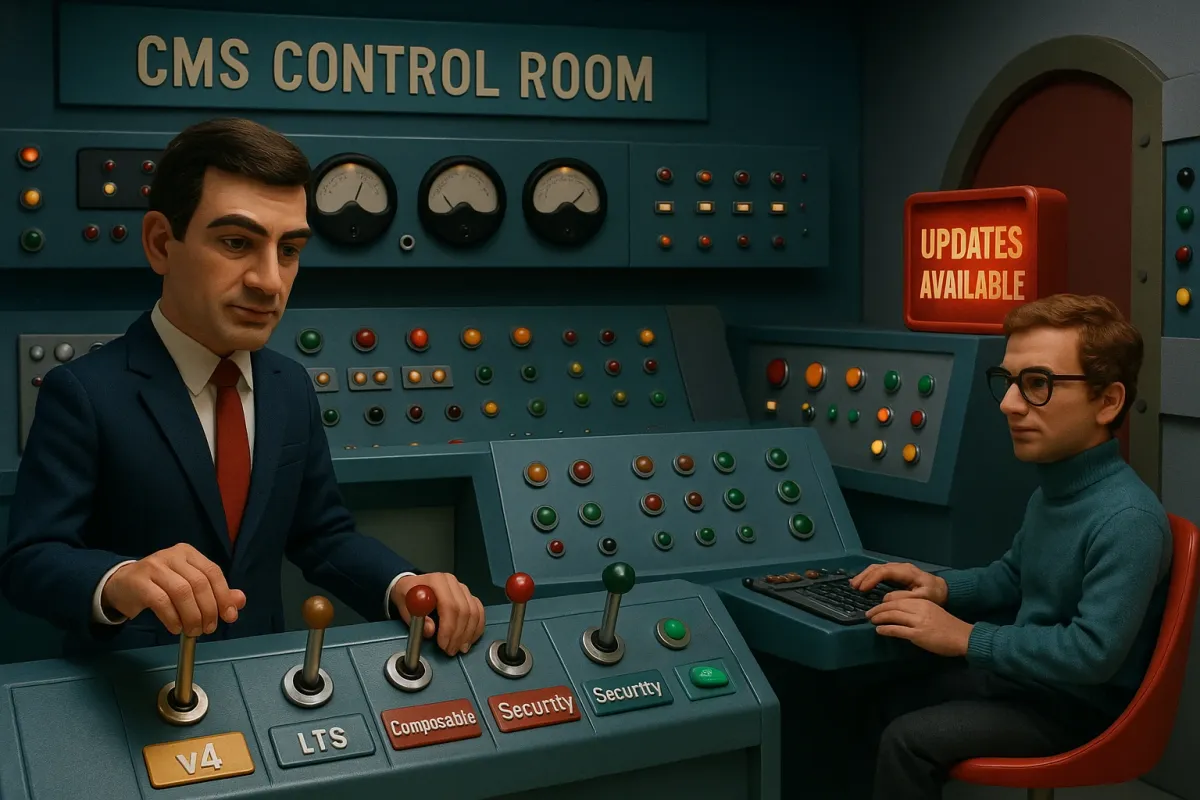When Should You Upgrade Your CMS? Balancing Risk, Reward and Reality

Content Management Systems (CMS) are the digital backbone of many businesses' online presence. They power e-commerce platforms, support marketing teams and serve as the foundation for most online experiences. But the question of when to upgrade your CMS is one we’re asked time and again - and the answer is rarely straightforward.
We were recently talking to a client who still runs an Umbraco v4 instance. Despite its age, it's stable and quietly processes over £1 million in turnover per month. From a business perspective, there's no urgency to upgrade. But from a technology standpoint, that’s where things become more nuanced.
This tension - between business continuity and technical progression - is something most organisations eventually face.
The Business Case vs the Technical Case
Let’s be honest. Even if you have complete confidence in your CMS vendor’s release cycle, it doesn't mean you’ll be upgrading in sync. It’s easy for “upgrade projects” to get de-prioritised in favour of initiatives with more visible ROI.
Stakeholder availability, internal resource and budget always play a role. And often the most influential sentiment in the room is: “If it ain’t broke, don’t fix it.”
Yet, sticking with a legacy CMS version does introduce risk:
- Security vulnerabilities from outdated dependencies
- Browser or device compatibility issues as standards evolve
- Performance degradation as traffic grows or integrations become brittle
- Poor editorial experience, which can hurt content velocity
The Rise (and Responsibility) of Composable
We’re advocates of composable CMS and commerce architecture at TSD. It’s an approach that lets you cherry-pick best-of-breed tools: one system for content, another for personalisation, another for checkout.
It’s liberating from a feature perspective. But there’s a trade-off - and it’s not one that’s often talked about.
You’re now responsible for keeping many more moving parts up to date.
With WordPress, the burden of updates has always been clear. But now even enterprise platforms (whether self-hosted or cloud) require frequent updates, regression testing and occasional rework to ensure compatibility across your stack.
Cloud-based platforms don’t remove the problem entirely. Even if the vendor handles the deployment, you still need to test your solution works with their latest version.
Maintenance Is a Discipline, Not a Project
At TSD, we encourage clients to adopt a maintenance mindset from day one.
We build automated tests where we can. We create maintenance plans tailored to the level of risk and resource appetite of the business. But it’s still time-consuming. Especially when updates come with breaking changes or significant editor UI shifts.
Depending on the business, we generally see three practical approaches to CMS version management:
1. Ignore Updates and Overhaul Later
This is surprisingly common and often completely rational. If your infrastructure is well secured and there’s a solid engineering team monitoring core changes, the risk can be mitigated.
The reward? Reduced ongoing dev cost and minimal disruption.
The risk? One day, you'll hit a wall where something critical breaks, and the upgrade path has become a complete rebuild.
2. Apply Every Release to Keep Change Small
Some of our clients take this path, and it keeps their stack nimble.
By implementing each release, the engineering effort per release is small, and major rewrites are avoided.
The downside? A continuous flow of development work. You’re always paying a tax to stay current and sometimes getting the pointy-end-of-the-stick and using features which are ultimately disliked/rolled back.
3. Stick to Long-Term Support (LTS) Versions Only
This is the most popular middle ground. You ignore minor updates but jump on each LTS release cycle to ensure support, security patches and compatibility with major browser/OS updates.
You’ll still need testing time and developer resource, but you’re not changing every few months.
So When Should You Upgrade?
There’s no universal rule. But here are a few guidelines:
| Situation | Suggested Upgrade Strategy |
|---|---|
| Stable turnover, legacy platform, no new features needed | Defer upgrades, review annually |
| Regular feature releases needed | Stay on LTS, upgrade periodically |
| High growth business or replatforming soon | Ignore short-term updates, plan for full rebuild |
| Heavily integrated stack | Apply updates regularly or risk compatibility issues |
What We’ve Learned at TSD
Over the past two decades, we’ve supported everything from heritage Sitefinity builds to headless Shopify integrations. A key learning has been this:
Upgrades are rarely technical decisions. They’re operational ones.
Yes, we’ve helped clients migrate from unsupported CMS platforms. Yes, we’ve rebuilt monoliths into microservice-led architectures. But we’ve also advised clients not to upgrade when the cost clearly outweighs the benefit.
If you're still running Umbraco v4 and it's processing £1m a month, you're not doing anything wrong. But you do need to have an honest conversation with your tech team every six months, check your security posture, audit your dependencies, and be ready to budget if things change.
Closing Thought
If you’re building anything today - whether on Umbraco, Dynamic Web, Sitefinity, Shopify or a custom headless CMS - understand that software maintenance is now a continuous practice. Not because platforms are failing, but because digital ecosystems are more interconnected than ever.
At TSD, we help retailers and ambitious businesses balance innovation with operational reality. If you're unsure where your CMS stands or what the cost of doing nothing might be in 12 months, we’d be happy to discuss it.
